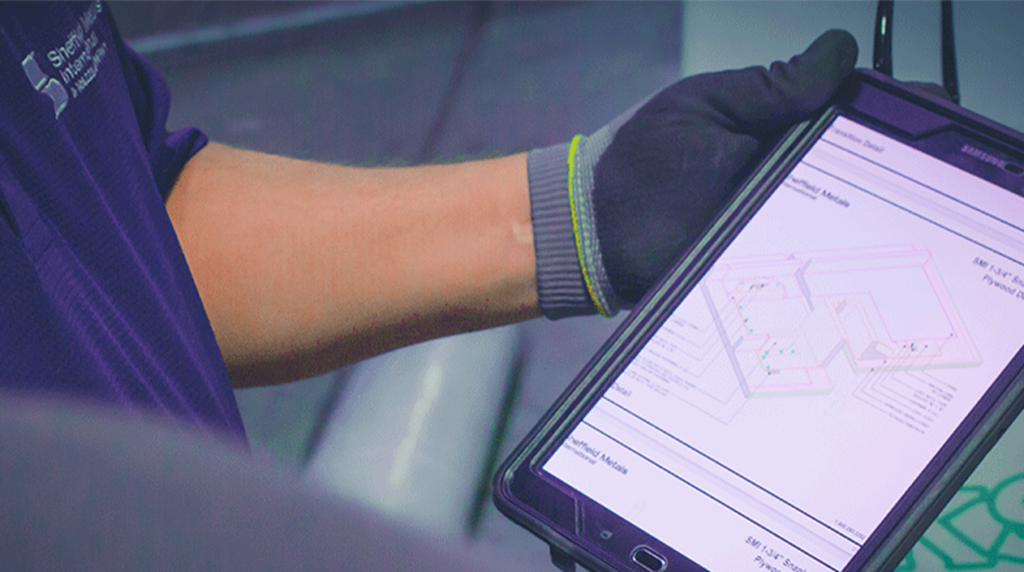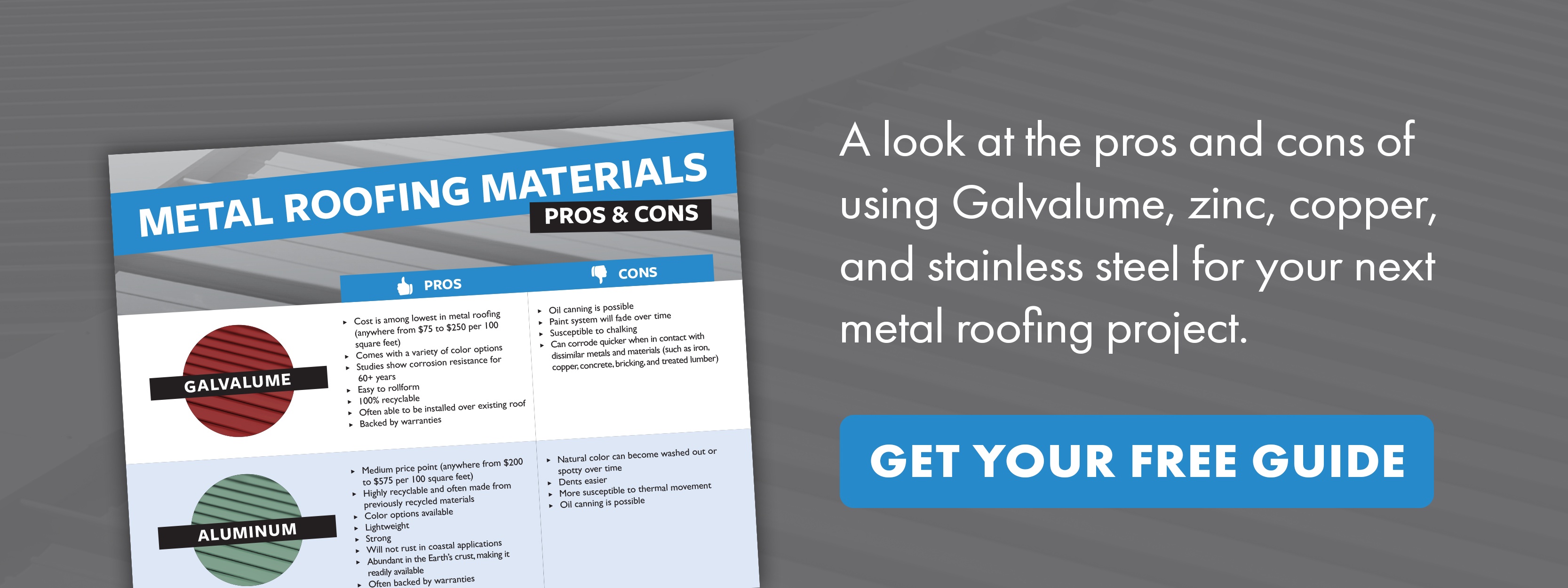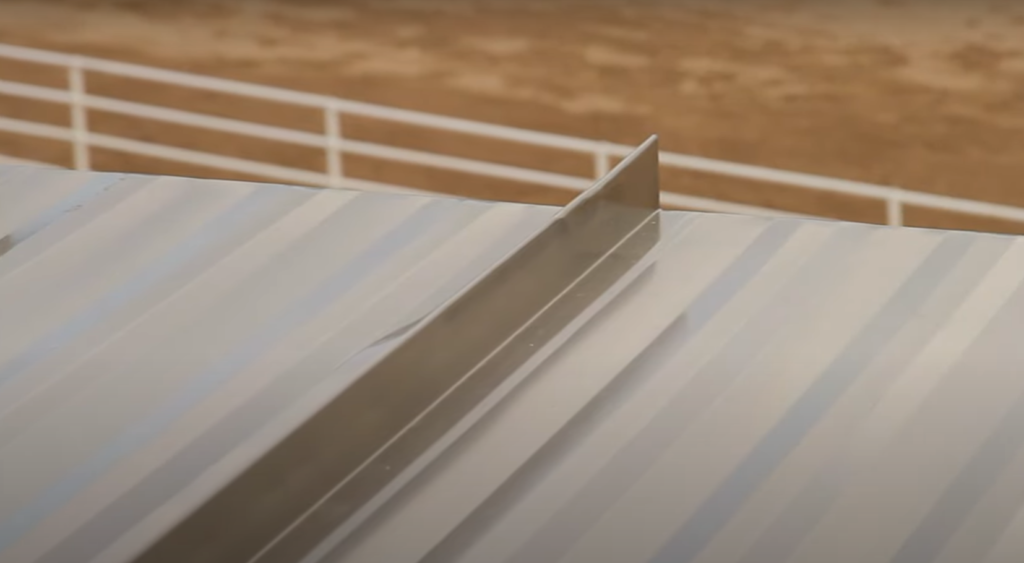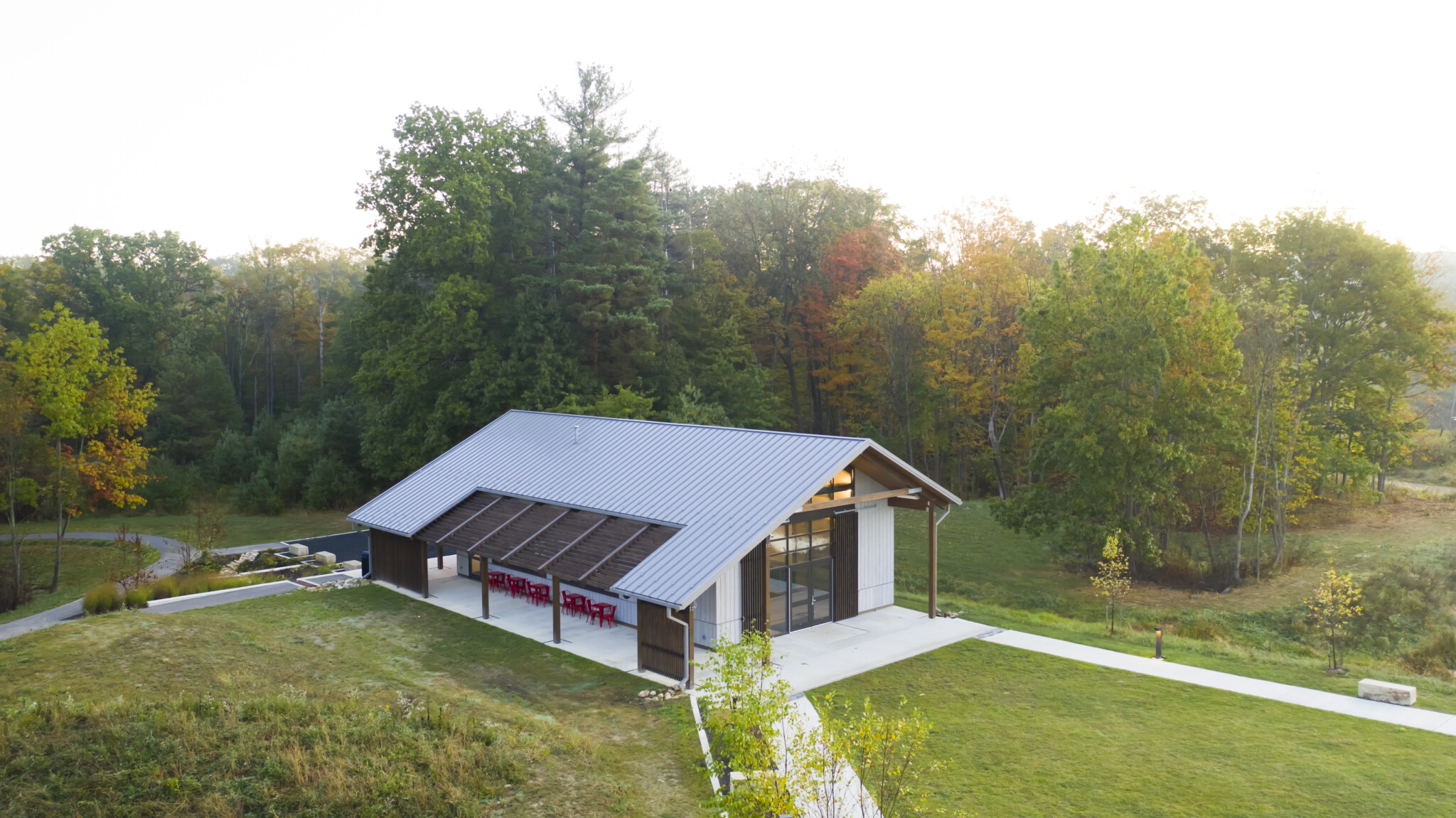Mechanically locked metal roofing profiles have been a standard panel option in the architectural standing seam roofing industry for many years.
Not only do mechanical seam profiles perform to the high standards that many architects, contractors, manufacturers, and commercial property owners desire for their projects — they also carry excellent warranties and are suitable for use on nearly any roof application.
One such mechanical seam option is the Sheffield Metals 2.0” Mechanical Seam profile. Our customers who do more commercial or architectural projects typically use this profile, but there are still many considerations to know about before you specify or choose this profile.
Sheffield Metals has focused on offering engineered and non-engineered standing seam profiles for metal roof and wall systems. Whether your project is residential or commercial, big or small, solid decking or otherwise – we have a panel profile that will work for you.
So, let’s discuss the SMI 2.0” Mechanical Seam profile, its specifications, when to use it, and when not to use it.
Sheffield Metals 2.0” Mechanical Seam Specifications
The Sheffield Metals 2.0” Mechanical Seam profile goes by a few different names or nicknames, including:
- SMI 2.0” Mechanical Seam
- SMI 2.0” MS
- The 2.0” Mechanical Lock
Keep in mind that there are various 2.0” mechanically seamed profiles that other manufacturers offer in the market. For this article, we are ONLY discussing the Sheffield Metals 2.0” Mechanical Seam profile. Please refer to a specific manufacturer’s installation details and specifications for their 2-inch mechanical seam profile options.
Panel & Seam Type
The Sheffield Metals 2.0” Mechanical Lock profile is a standing seam panel type with a mechanically locked seam. This means that the panel edges have vertical legs that line up, so the male leg goes down, then the clip goes over that leg and is fastened down. Then, the female leg of the panel goes over the clip to conceal it. These components are then seamed together by either a single lock (90-degree bend) or a double lock (180-degree bend). Because there are two different folding options, it’s critical that you know which is required with the engineering. Most of the time, it’s the double-lock 180-degree seam.
Mechanically-seamed profiles are typically engaged using a robotic seaming tool, including the SMI 2.0” MS. These robotic seaming tools give the finished roof a cleaner, more consistent look than hand seaming tools. Installers can use hand seaming tools; however, it will take a significant amount of time and extra labor to hand seam the entire roof to 180 degrees.
Pro tip: Hand seaming tools work well for making 90-degree bends at the clip locations. This creates a fixed point while you lay down the panels to go back and seam with a robotic seaming tool later (per the seamer manufacturer’s instructions). Also, putting this 90-degree seam over the clip makes it easier for the robotic seaming tool to finish the 180-degree seam.

Metal Materials
For the SMI 2.0” Mechanical Seam profile engineering, you can use 22 to 24-gauge steel (Galvalume) or .040 aluminum to form the panels. You can also use the same metal materials in a heavier (thicker) gauge or a narrower width panel and still have valid engineering.
Panel Width
On the 2.0” Mechanical Seam profile, the finished panel width for our engineering is:
- 18” for steel (Galvalume) panels
- 16” for aluminum panels
This specific panel requires approximately 5-13/16” of metal sheet/coil to rollform the appropriate seams and edges.
If you rollform your panels or plan to use on-site portable rollforming, you will use:
- 24” coil/sheets to make steel (Galvalume) panels
- 22” coil/sheets to make aluminum panels
For reference, if you take the square footage of the roof and multiply it by 1.34, it will equal the total amount of coil needed to manufacture the SMI 2.0” MS profile panels (however, this doesn’t account for the waste factor).
Seam Height
The seam height for this profile is 2.0 inches.
Slope Minimum & Requirements
The slope requirements for the 2.0” Mechanical Seam profile are:
- Steel (Galvalume) = down to a .5/12 slope
- If this profile system is installed below a 2/12 in steel, you must install in-seam sealant, per ASTM E 2140.
- Aluminum = down to a 2/12 slope
We’ll discuss slope requirements more in detail in this article’s “When to Use the SMI 2.0” Mechanical Seam” section.
Roof Deck Substrates
For the engineering on this profile, we have tested the 2.0” Mechanical Seam assembly on plywood, b-deck (metal decking), b-deck with ISO (polyisocyanurate insulation), and open framing applications.

Weathertight Warranties
Sheffield Metals offers optional 5 to 35-year weathertight warranties on commercial structures that use select SMI engineered profiles. The SMI 2.0” Mechanical Seam panel profile qualifies for these weathertight warranties (based on the project design).
Paint & Substrate Warranties
Both aluminum and steel SMI 2.0” MS roof systems carry a 40-year transferable PVDF paint/finish warranty (available from Sherwin-Williams). Additionally, substrate warranties are available; warranty length, inclusions, and exclusions will vary depending on the material type and project location.
Installation Details
The SMI 2.0” MS profile has installation details for steel and aluminum over plywood, b-deck, and b-deck with ISO. Additionally, there are installation details for steel over open framing. Metal roof installation details provide an in-depth product guide detailing the location of accessories and explain the basic practical installation methods for these products at various points on the roof.
As always, make sure to follow the engineering guidelines as to what deck substrate you can install over, proper clip spacing, approved accessories, and other additional requirements. Please visit the profile product page to download any of the 2.0” Mechanical Seam installation details.
Miscellaneous Specifications & Requirements
There are a few other elements that are specific to the SMI 2.0” Mechanical Seam profile, including:
- Panel surface options: Smooth or embossed (optional)
- Panel clip requirement(s): Required per engineering
- There are multiple types of clips used for various engineered conditions. The specific engineering requirements for your project will determine the appropriate clip to use.
- Compatible S-5! attachment clamp(s): S-5-U or S-5-H90

Engineering, Testing, & Approvals on the SMI 2.0” Mechanical Seam Profile
Uplift Testing: UL 580 & 1897 (Standard for Tests for Uplift Resistance of Roof Assemblies)
Substrate material: Steel
- Deck types: Plywood, b-deck, b-deck with ISO, and open framing
- Result: Pass (completed Class 90 and went on into UL 1897. During UL 1897, the system maintains a positive pressure and increases negative pressure until the system fails).
Substrate material: Aluminum
- Deck types: Plywood, b-deck, and b-deck with ISO
- Result: Pass (completed Class 90 and went on into UL 1897).
Air Infiltration Testing: ASTM E1680 (Standard Test Method for Rate of Air Leakage Through Exterior Metal Roof Panel Systems)
Substrate material(s): Steel and aluminum
Deck types: Plywood, b-deck, and b-deck with ISO
Result: Pass
Wind-Driven Rain: Testing Application Standard (TAS) No. 100–95 Test Procedure For Wind and Wind-Driven Rain Resistance Of Discontinuous Roof Systems
Substrate material(s): Steel and aluminum
Result: Pass
Water Penetration Testing: ASTM E1646 (Standard Test Method for Water Penetration of Exterior Metal Roof Panel Systems by Uniform Static Air Pressure Difference)
Substrate material(s): Steel and aluminum
Deck types: Plywood, b-deck, and b-deck with ISO
Result: Pass
Water Submersion Testing: ASTM E2140 (Standard Test Method for Water Penetration of Metal Roof Panel Systems by Static Water Pressure Head)
Substrate material(s): Steel ONLY
Result: Pass

Impact Resistance Testing: UL 2218 (Impact Resistance of Prepared Roof Covering Materials)
Substrate material(s): Steel and aluminum
Result: Class 4 (best rating / most likely to resist surface penetrations based on testing criteria)
Fire Rating: UL 790 (Standard for Standard Test Methods for Fire Tests of Roof Coverings)
Substrate material(s): Steel and aluminum
Result: Class A (best rating / least likely to combust or catch fire)
Foot Traffic: FM Approvals 4471 Foot Traffic Resistance Test
Substrate material(s): Steel ONLY
Deck types: Open framing ONLY
Result: Pass (no panel punctures, separation, or disengagement when a 250 lb. concentrated load was repeatedly placed on the panels over open framing with 5’ purlin spacing on center)
Florida Building Code (FBC)
Substrate material: Steel
- Deck types: Plywood, b-deck, and b-deck with ISO
- Result: Approved
Substrate material: Aluminum
- Deck types: Plywood ONLY
- Result: Approved
Texas Department of Insurance (TDI)
Substrate material(s): Steel ONLY
Deck types: Plywood, b-deck, and b-deck with ISO
Result: Approved
UL 90 Construction Numbers
SMI 2.0″ MS UL 90 Test – Construction No. 610
When to Use the SMI 2.0” Mechanical Seam Profile
On a low or steep-slope application – Mechanically seamed profiles are effective on both steep-slope and low-slope roof surfaces, including the SMI 2.0” Mechanical Seam profile. Depending on the design of your project and the location, this profile can be installed down to as low as a .5/12 roof slope in steel (aluminum’s minimum slope requirement for our engineering is 2/12). If you install this profile system below a 2/12 in steel, you must use continuous in-seam sealant to adhere to ASTM E 2140 standards and keep the seam as water-tight as possible. For a bit of background, double-lock mechanically seamed profiles are going to provide the most protection and extra weather-tightness on any structure, especially low-sloping roofs. Plus, there is less chance for panels to come unseamed, which is essential in low-slope situations and in locations where freezing and thawing (and therefore expansion and contraction) occur.
Your roof system is or needs to be hydrostatic – Going along with slope factors is the term “hydrostatic,” which refers to panel systems that are a 3/12 slope or less and are designed to hold water and drain slower. Hydrostatic systems have a higher potential to become submerged as the water moves slowly off the roof surface. This is why it’s critical to protect against water intrusion, which you get with the SMI 2.0” Mechanical Seam profile. Remember that your roof system must adhere to our manufacturer’s details, including the in-seam sealant and an ice and water shield synthetic underlayment.

Your project is commercial – The SMI 2.0” MS system is almost exclusively installed on commercial projects because of the:
- Size and shape – This profile seam is one of the taller panel systems and can be considered “industrial looking,” which is more common for large commercial properties. A tall or industrial-looking seam might be regarded as too prominent on a residence.
- Cost – Installing a mechanically seamed system will add labor and material costs to the installation, as the contractors have to seam the panels together.
- Superior durability – Commercial properties tend to have more strict engineering requirements and codes that they have to follow. The 2.0” MS is a profile tested to hold up to some of the most extreme weather conditions for several decades.
You want a commercial weathertight warranty – One common reason architects specify and contractors install the 2.0” MS profile is that it qualifies for our commercial weathertight warranties (limited and no dollar limit weathertight warranty options available). If your property is a commercial structure, you’re likely spending a significant amount of money on your new standing seam metal roof. That’s why we recommend considering a weathertight warranty, as it’s designed to protect your investment.
You want or need to install an engineered metal roofing system – A reason the SMI 2.0” Mechanical Seam is so popular is that it’s engineered, tested, and proven to perform on numerous roof deck assemblies (plywood, b-deck, b-deck w/ ISO, and open framing) with different materials (steel and aluminum).
You’re installing over open framing – The SMI 2.0” MS profile is one of few panels that carry engineering when installed over open framing. However, engineering is only available for steel roofs that follow the specified engineering requirements for open framing applications. Additional note: In order to meet UL 90 standards, the purlin spacing must be 4’ or less.
When NOT to Use the SMI 2.0” Mechanical Seam Profile

You don’t have a robot or hand seaming tool – As we discussed, this profile requires seaming for the panels to be engaged and secured to the deck. If you don’t have access to a robotic seaming tool, don’t have a hand seaming tool, or are physically unable to seam the panels together, do not specify or install the 2.0” MS profile. (Note: If you are looking for seaming tools, we recommend renting or buying the equipment through our partners at Quality Roof Seamers.)
You have a limited budget – Robotic or hand seaming is involved and takes longer to complete, which means more labor is required. This longer installation time frame will likely raise the price. Plus, if the slope is below 2/12, you also have to add sealant to put between the seams, increasing the cost.
You’re a DIY home/building owner installing your roof – There are some metal roofs (mostly metal shingles) that skilled DIYers can install, but the SMI 2.0” Mechanical Seam is not one of them. This profile requires a roofing professional to do the rollforming, installing, and seaming, which is often beyond the capabilities of most DIYers. And when it comes to something as critical as a roof, it’s often not worth the risk, as a roof failure can cause significant damage to a structure and property.
Your project is on a residential property – As we mentioned, there are very few homes where the 2.0” MS profile is utilized. There are various cheaper options, including the SMI 1.5” Mechanical Seam, that are smaller, provide a similar level of engineering, and are more suited for residential applications.
Completed Project(s) Using the SMI 2.0″ MS
Final Thoughts on the SMI 2.0” Mechanical Seam Standing Seam Profile
The Sheffield Metals 2.0″ Mechanical Seam isn’t the only mechanically locked profile that we offer, but it’s a commonly specified and installed profile to use on your commercial or architectural projects.
This article discussed the specifications, engineering/testing, and use cases for this profile. But if you’re still trying to decide between the 2.0″ MS or another profile, you can better understand which one is best for you by asking these questions:
- What is the pitch of my roofing structure?
- Is my project commercial or residential?
- Do I want/need an engineered metal roofing system?
- Do I want/need a weathertight warranty?
- Will the installer have access to a seaming tool? Can they rent one?
- What is the roof deck substrate material?
- How long and wide do I want/need the panels to be?
- Is this roof being installed by a professional? DIYer?
- How much do I want to spend?
- Is my budget flexible? Am I able to cover added labor or material costs?
At Sheffield Metals, we provide our customers with everything they need to successfully specify and install a standing seam metal roofing, including profile engineering, materials, instructions, details, and technical support. That’s why we offer a variety of tested and proven panel profiles, including the SMI 2.0″ Mechanical Seam, designed to meet your project requirements.
Please contact one of our experienced technical representatives to learn more about the 2.0″ MS or any of our panel profile options!




